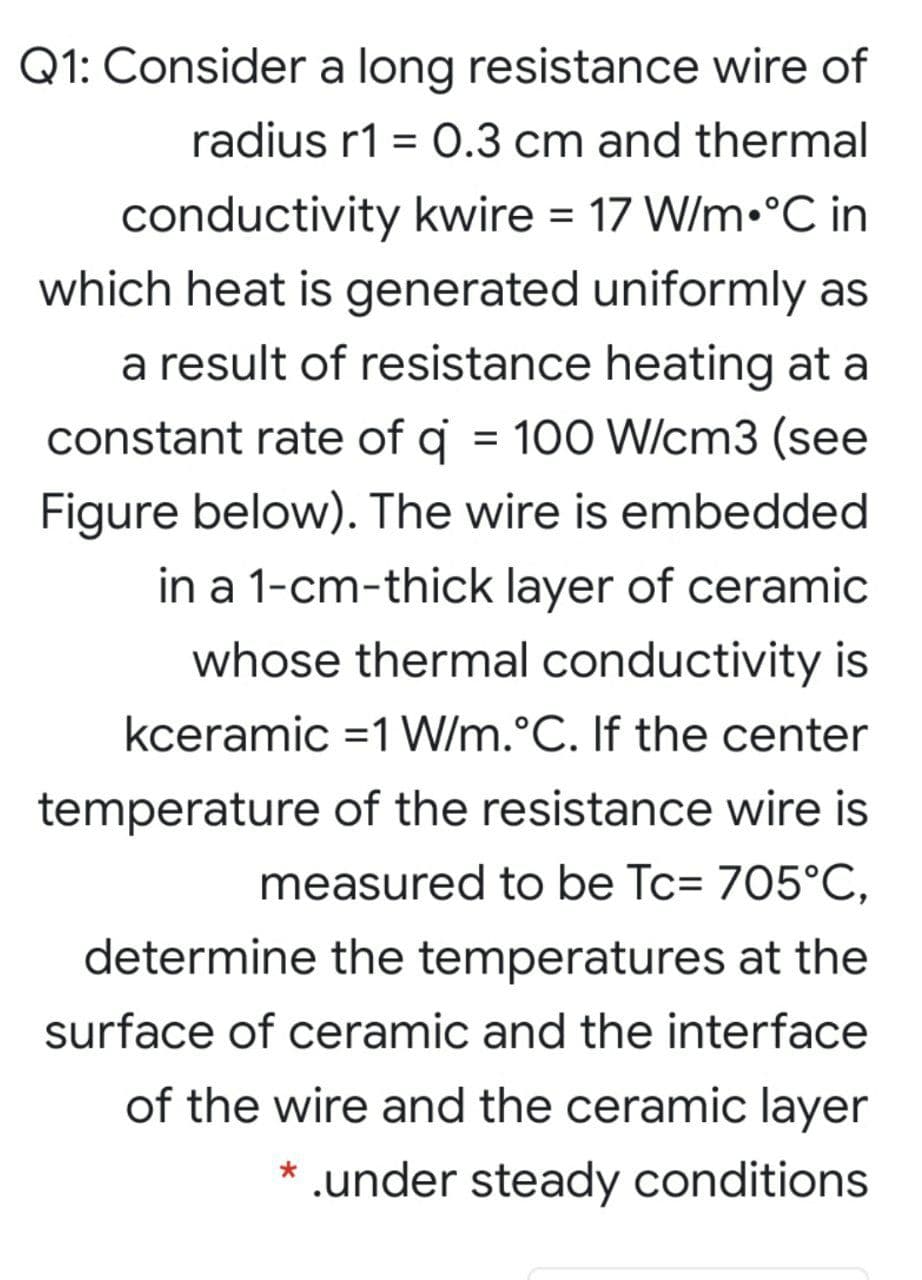Q1: Consider a long resistance wire of radius r1 = 0.3 cm and thermal conductivity kwire = 17 W/m.°C in which heat is generated uniformly as a result of resistance heating at a constant rate of q = 100 W/cm3 (see Figure below). The wire is embedded in a 1-cm-thick layer of ceramic whose thermal conductivity is kceramic =1 W/m.°C. If the center temperature of the resistance wire is measured to be Tc= 705°C, determine the temperatures at the surface of ceramic and the interface of the wire and the ceramic layer .under steady conditions
Q1: Consider a long resistance wire of radius r1 = 0.3 cm and thermal conductivity kwire = 17 W/m.°C in which heat is generated uniformly as a result of resistance heating at a constant rate of q = 100 W/cm3 (see Figure below). The wire is embedded in a 1-cm-thick layer of ceramic whose thermal conductivity is kceramic =1 W/m.°C. If the center temperature of the resistance wire is measured to be Tc= 705°C, determine the temperatures at the surface of ceramic and the interface of the wire and the ceramic layer .under steady conditions
Principles of Heat Transfer (Activate Learning with these NEW titles from Engineering!)
8th Edition
ISBN:9781305387102
Author:Kreith, Frank; Manglik, Raj M.
Publisher:Kreith, Frank; Manglik, Raj M.
Chapter2: Steady Heat Conduction
Section: Chapter Questions
Problem 2.47P
Related questions
Question

Transcribed Image Text:Q1: Consider a long resistance wire of
radius r1 = O.3 cm and thermal
conductivity kwire = 17 W/m•°C in
which heat is generated uniformly as
a result of resistance heating at a
constant rate of q = 100 W/cm3 (see
%3D
Figure below). The wire is embedded
in a 1-cm-thick layer of ceramic
whose thermal conductivity is
kceramic =1 W/m.°C. If the center
temperature of the resistance wire is
measured to be Tc= 705°C,
determine the temperatures at the
surface of ceramic and the interface
of the wire and the ceramic layer
* .under steady conditions
Expert Solution
This question has been solved!
Explore an expertly crafted, step-by-step solution for a thorough understanding of key concepts.
This is a popular solution!
Trending now
This is a popular solution!
Step by step
Solved in 2 steps with 2 images

Knowledge Booster
Learn more about
Need a deep-dive on the concept behind this application? Look no further. Learn more about this topic, mechanical-engineering and related others by exploring similar questions and additional content below.Recommended textbooks for you

Principles of Heat Transfer (Activate Learning wi…
Mechanical Engineering
ISBN:
9781305387102
Author:
Kreith, Frank; Manglik, Raj M.
Publisher:
Cengage Learning

Principles of Heat Transfer (Activate Learning wi…
Mechanical Engineering
ISBN:
9781305387102
Author:
Kreith, Frank; Manglik, Raj M.
Publisher:
Cengage Learning